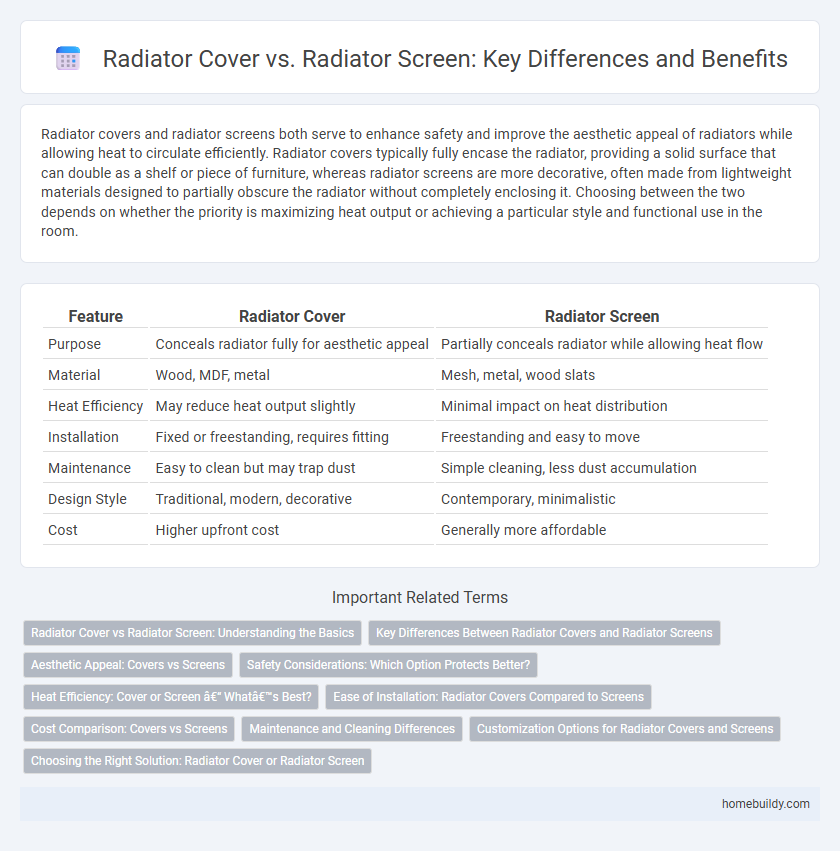Radiator covers and radiator screens both serve to enhance safety and improve the aesthetic appeal of radiators while allowing heat to circulate efficiently. Radiator covers typically fully encase the radiator, providing a solid surface that can double as a shelf or piece of furniture, whereas radiator screens are more decorative, often made from lightweight materials designed to partially obscure the radiator without completely enclosing it. Choosing between the two depends on whether the priority is maximizing heat output or achieving a particular style and functional use in the room.
Table of Comparison
| Feature | Radiator Cover | Radiator Screen |
|---|---|---|
| Purpose | Conceals radiator fully for aesthetic appeal | Partially conceals radiator while allowing heat flow |
| Material | Wood, MDF, metal | Mesh, metal, wood slats |
| Heat Efficiency | May reduce heat output slightly | Minimal impact on heat distribution |
| Installation | Fixed or freestanding, requires fitting | Freestanding and easy to move |
| Maintenance | Easy to clean but may trap dust | Simple cleaning, less dust accumulation |
| Design Style | Traditional, modern, decorative | Contemporary, minimalistic |
| Cost | Higher upfront cost | Generally more affordable |
Radiator Cover vs Radiator Screen: Understanding the Basics
Radiator covers are solid structures designed to enclose a radiator completely, providing safety and an aesthetic appeal by hiding the radiator while allowing heat to circulate through vents or grilles. Radiator screens, on the other hand, are decorative panels or mesh placed in front of radiators to improve appearance without fully enclosing the unit, offering less heat retention and protection compared to covers. Understanding these differences helps in choosing between enhanced heat efficiency and room safety or simpler cosmetic improvement.
Key Differences Between Radiator Covers and Radiator Screens
Radiator covers typically enclose the entire radiator unit, providing a solid, often decorative surface that conceals the heater while improving room aesthetics and safety by preventing direct contact. Radiator screens, on the other hand, are primarily designed as partial barriers with a slatted or perforated design that allows more heat circulation but offers less comprehensive coverage. Key differences include heat efficiency, as covers may slightly reduce heat output due to enclosure, whereas screens maximize heat dispersion, and aesthetic impact, with covers offering a more integrated look versus the minimalistic function of screens.
Aesthetic Appeal: Covers vs Screens
Radiator covers provide a solid, often decorative barrier that can enhance a room's aesthetic by blending the radiator into the overall decor with materials like wood or metal panels. Radiator screens, typically made from perforated or latticed metal, offer a more open design that balances visual appeal with improved heat circulation. Choosing between covers and screens depends on whether the priority lies in concealing the radiator completely or showcasing it as a subtle design feature.
Safety Considerations: Which Option Protects Better?
Radiator covers provide a solid barrier that reduces the risk of burns by fully enclosing hot surfaces, making them ideal for homes with children or pets. Radiator screens, often made from metal slats or mesh, allow better heat circulation but offer less comprehensive protection against accidental contact. Choosing between a radiator cover and screen depends on prioritizing safety or heat efficiency, with covers generally offering superior protection against burns.
Heat Efficiency: Cover or Screen – What’s Best?
Radiator covers typically reduce heat efficiency more than radiator screens because covers enclose the radiator, restricting airflow and trapping heat inside. Radiator screens, designed with open slats or mesh, allow better heat circulation, maximizing warmth transfer to the room. For optimal heat efficiency, choosing a screen over a cover is generally recommended, especially in spaces where heating performance is a priority.
Ease of Installation: Radiator Covers Compared to Screens
Radiator covers typically offer easier installation compared to radiator screens due to their straightforward design, often requiring only simple tools like screws or brackets. Covers usually come pre-assembled or in ready-to-fit panels that attach directly to the radiator, minimizing setup time. In contrast, radiator screens may involve more complex mounting systems or custom fitting, making covers the preferred choice for quick and hassle-free installation.
Cost Comparison: Covers vs Screens
Radiator covers generally cost more than radiator screens due to their solid construction and added features like storage or decorative panels. Radiator screens are usually more affordable, made from lightweight materials such as metal or mesh, providing basic protection without significant design elements. Choosing between covers and screens depends on budget priorities, with covers offering enhanced aesthetics at a higher price and screens delivering cost-effective safety.
Maintenance and Cleaning Differences
Radiator covers typically require more extensive cleaning due to their enclosed design, which can trap dust and restrict airflow if not regularly maintained. Radiator screens, featuring open slats or perforations, offer easier access for dusting and allow better air circulation, reducing the frequency of deep cleaning. Choosing between a radiator cover and screen depends on balancing aesthetic preferences with maintenance convenience and airflow efficiency.
Customization Options for Radiator Covers and Screens
Radiator covers offer extensive customization options including various materials like wood, metal, and MDF, along with customizable sizes, colors, and intricate design patterns tailored to match interior decor. Radiator screens generally provide fewer customization choices, often limited to standard sizes and simpler designs primarily in metal or plastic. Homeowners seeking to blend functionality with personalized aesthetics typically prefer radiator covers for their versatility in customization.
Choosing the Right Solution: Radiator Cover or Radiator Screen
Radiator covers provide a solid barrier that protects against burns and improves room aesthetics by concealing the entire radiator, while radiator screens offer partial coverage allowing better heat circulation with a decorative touch. Choosing the right solution depends on balancing safety, heat efficiency, and style preferences, with covers ideal for childproofing and screens suited for enhancing airflow. Consider room size, radiator type, and safety needs to determine whether a sturdy cover or a more ventilated screen best suits your space.
Radiator cover vs Radiator screen Infographic

 homebuildy.com
homebuildy.com